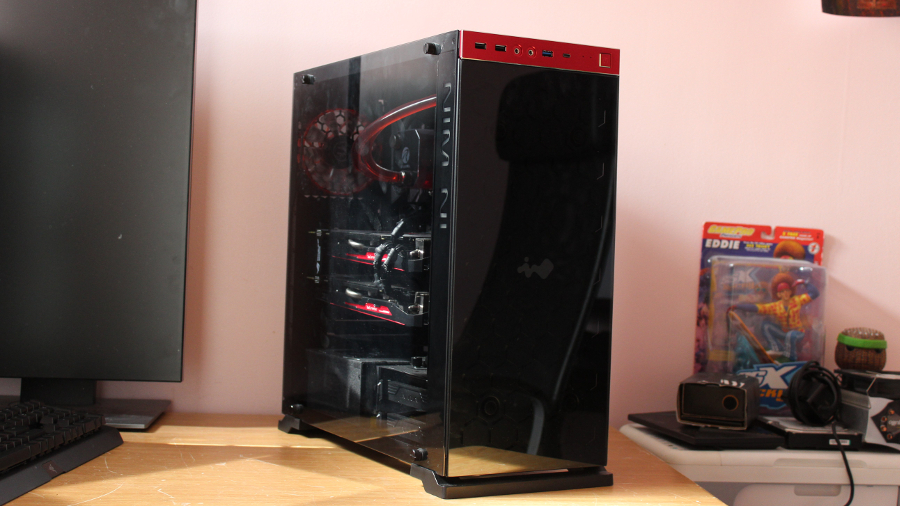TechRadar Verdict
This expensive machine justifies its price with ridiculous gaming speed and stellar performance in every other category. It's well-made, too, with a striking case and solid build quality. Our qualms are minor - the price is high, of course, and interior access is a little cramped - but those are our only issues.
Pros
- +
Incredible gaming power
- +
High-end components
- +
Striking glass chassis
Cons
- -
Intimidatingly expensive
- -
Cramped interior
- -
Inferior CPU overclocking
Why you can trust TechRadar
The latest system from Crewe-based PC builder Palicomp is a no-nonsense gaming desktop packed with benchmark-breaking components. It has the brawns to play any game at 4K or through a VR headset thanks to a pair of graphics cards, joined by a high-end SSD and an overclocked Core i7 processor.
For this monster rig, though, you'll have to pay almost $4,268 (about £2,999 inc VAT, AU$5,578). And while this machine will handle games now and for years into the future, that's a huge amount of money to spend in one go.
The Palicomp's price tag puts it in the same extreme ballpark as the Overclockers 8Pack Asteroid, but these are very different systems. The Infantry General is a traditional tower where power is more important than looks – and the Asteroid is a mini-ITX rig that's designed to impress aesthetically as well as play games.
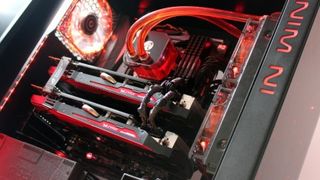
Design
The Infantry General revolves around an InWin 805 chassis. It's a normal tower when it comes to size and layout, but it immediately draws glances with its front and side panels – no surprise, as they're made of glass.
The tinted front panel lights up with a honeycomb pattern and red lights hidden inside of the case, and the side-mounted sheets of glass allow the entire interior to be seen.
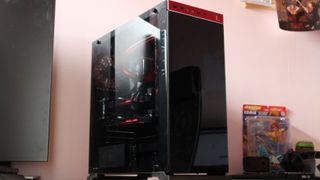
It's quite an interior, too. The middle of the chassis is dominated by two red-tinged Asus Strix GeForce GTX 980 Ti graphics cards, and the front of the case holds a Raijintek Triton water-cooling unit. From there two pipes filled with red coolant snake towards the Raijintek water-block, which sits on top of the processor and bubbles with coolant through its clear resin.
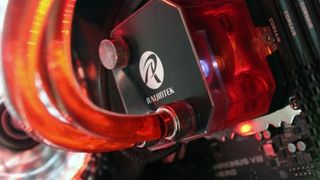
The red theme continues elsewhere. The numerous case fans are furnished with red LEDs, and Palicomp has installed crimson lighting strips around the case's borders. The Asus motherboard is topped off with red accents as well.
The bright colours stand out against the dark interior and motherboard and make for a great-looking system. It's not as outlandish as the Overclockers, but it's a top-notch tower that draws admiring glances in any room.
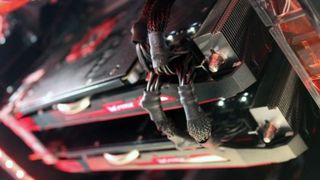
Cramped interior
The Infantry General is a good-looking system packed with high-end components, but the wealth of hardware means that it's tricky to upgrade.
The pair of graphics cards make it virtually impossible to get to the free PCI-Express and PCI slots and the empty SATA ports on the back of the motherboard, Even the simple things like replacing memory will require you replace the whole set of as all four memory sockets are already occupied. There's room for a couple of extra hard disks, but they sit inside flimsy plastic cages.
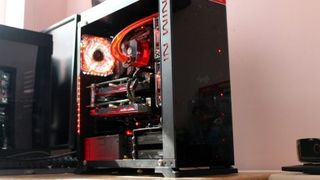
This isn't a PC that's really suitable for upgrading after purchase, but Palicomp does offer a few different configuration options right out of the factory. CPU overclocking can be tweaked, and several different coolers are available on top of the usual storage and graphics card options.
Palicomp's standard warranty is a three-year return policy that includes a year of parts coverage, but that can be upgraded too. The firm's "carefree" warranty is a collect-and-return deal that includes several free upgrades to the PC, and it's available in one- and three-year configurations.
Specifications
This a machine designed to scythe through games, so it's no surprise that Palicomp has deployed two high-end Nvidia GeForce GTX 980 Ti GPUs. Each card also has 6GB of GDDR5 memory overclocked to 7,200MHz – so there's a mighty 12GB across the whole PC.
Those monster GPUs are backed up by an Intel Core i7-6700K. It's a quad-core part with Hyper-Threading and lashings of cache, and its 4GHz stock speed has been risen to 4.6GHz – just 100MHz slower than the Overclockers machine, which had the same CPU.
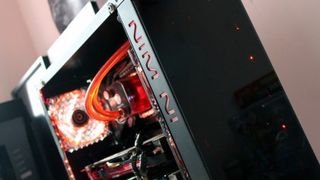
The Infantry General doesn't mess about in other departments, either. It has 32GB of memory clocked to a lightning-quick 3,200MHz, and its boot drive is a PCI-Express connected 500GB Samsung SM951 SSD. There's a 1TB Samsung 850 EVO SSD as a rapid halfway house, and a 4TB hard disk.
Everything connects to an Asus Maximus VIII Hero. It's one of the best laptops from the Republic of Gamers range, and it looks it: it's littered with gunmetal grey heatsinks and illuminated logos along with red accents.
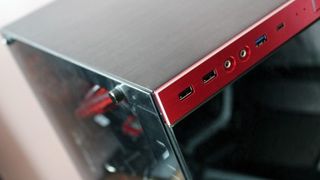
Beyond the configuration in the box, there's more room for loads of memory and multiple GPUs, numerous spare SATA ports, and there are dedicated audio circuits isolated with special shielding and a dedicated clock. A game-friendly Gigabit Ethernet and a host of buttons and connectors reside at the bottom of the motherboard, although the cramped interior makes them tricky to reach.
The backplate is well-stocked, too, with several USB 3 ports, USB 3.1 Type-A and Type-C connectors and five audio jacks.
Spec sheet
- CPU: 4GHz Intel Core i7-6700K processor (quad-core, 8MB cache, 4.6Ghz when overclocked)
- Motherboard: Asus Maximus VIII Hero
- Graphics: 2 x Nvidia GeForce GTX 980 Ti (6GB GDDR5 RAM)
- RAM: 32GB DDR4 (3,200MHz)
- Storage: 500GB Samsung SM951 PRO NVMe SSD; 1TB Samsung 850 EVO SSD; 4TB Seagate hard disk
- Connectivity: Gigabit Ethernet
- Operating system: Windows 10 64-bit
- Case: InWin 805
- Ports: Front: Rear 4 x USB 3, 1 x USB 3.1 Type-A, 1 x USB 3.1 Type-C, Optical S/PDIF, Gigabit Ethernet, 3 x audio
- Size: 10.5in x 14in x 11.6in (W x D x H; 267 x 357 x 295mm)
Benchmarks
- 3DMark: Cloud Gate: 25,908; Sky Diver: 36,796; Fire Strike: 21,404
- Cinebench R15: CPU: 1,004cb; Graphics: 184.16fps
- PCMark 8 (Home Test): 5,108
- GeekBench: 5097 (single-core); 19,847 (multi-core)
- Metro: Last Light: 147.6fps (1080p, Ultra); 116.1fps(1440p, Ultra); 71.1fps (4K, Ultra)
- Middle Earth: Shadow of Mordor: 169.9fps (1080p, Ultra); 137.4fps (1440p, Ultra); 78.3fps (4K, Ultra)
- Bioshock Infinite: 247.6fps (1080p, Ultra); 186.9fps (1440p, Ultra); 102.1fps (4K, Ultra)
- GTA V: 155.1fps (1080p, Ultra); 141.8fps (1440p, Ultra); 85.5fps (4K, Ultra)
- Steam VR Bench: VR Ready. Zero frames below 90fps
This high-end system battered our gaming benchmarks. Its result of 21,404 in the 3D Mark Fire Strike test is one of the best scores we've ever seen – and it's more than 4,000 points beyond the Overclockers 8Pack Asteroid.
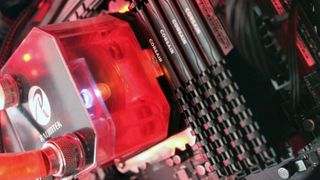
The Palicomp continued to perform well in synthetic GPU tests, with a Cinebench OpenGL result of 184.16fps – about level with the Overclockers Asteroid.
The Infantry General didn't balk at real-world games tests, either. Its framerates at 1080p ranged between 147.6fps to a ridiculous 247.6fps, and the Infantry General barely slowed down at 1440p – in our four test games at that resolution its frame rates ranged between 116.1fps and 186.9fps.
This dual-GPU machine didn't struggle with titles at 4K, either. Its poorest score at 3,840 x 2,160 came in Metro: Last Light, where the Infantry General still averaged a silky 71.1fps – and its best result was in Bioshock Infinite, where it managed 102fps.
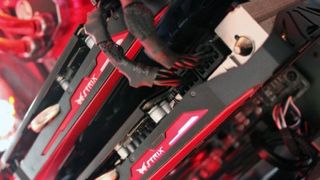
Palicomp's machine has the power to play any game at 4K, then, and that doesn't just bode well for high-resolution screens. It also means the Infantry General can play games across multi-monitor setups, widescreen and through VR headsets like the Oculus Rift and HTC Vive.
We ran Valve's VR benchmark just to make sure, and it confirms that the Palicomp is ready, with no frames that dropped below 90fps.
We've no complaints about the Palicomp's processing power, either. The Infantry General's Cinebench pace of 1,004cb was almost on par with the Overclockers system – no surprise, given there's only 100MHz between the two. And the Palicomp's PC Mark 8 result of 5,108 points bested the Asteroid's score of 4,840 points.
There's clearly no problem with application performance, then, thanks to the overclocked Core i7 silicon. The Palicomp will handle any application, and it won't hold back games either.
Palicomp's machine has a wider variety of storage than the Asteroid – no surprise, given its far larger chassis.
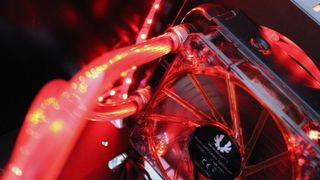
The most impressive drive is the Samsung 950 PRO NVMe SSD, which uses PCI-Express bandwidth to deliver stonking sequential read and write speeds of 2,199MB/s and 1,403MB/s. That's far better than the Asteroid, which used a SATA-based Samsung drive to score 493MB/s and 480MB/s – as the Overclockers system didn't have room for an M.2 SSD.
Even the Palicomp's secondary storage is slick. The 1TB Samsung 850 EVO delivered speeds of 383MB/s and 403MB/s – easily better than a hard disk.
Our final tests concern thermal and aural performance, and it's often an area where high-end systems begin to falter.
Palicomp's machine, though, performed well. Its peak processor temperature of 90°C is high but not dangerously toasty, and the graphics card topped out at a fine figure of 83°C. The system never proved loud, either; its low idle rumble only increased modestly during stress-tests. A headset or speakers will do a fine job of drowning out this machine's low whirr.
Final Verdict
Palicomp's machine is a good-looking tower system with a consistent red-and-black theme inside a case with side panels made of glass.
But it's clear that the Infantry General isn't designed to just look good – its primary function is ploughing through high-end games. Two overclocked GTX 980 Ti graphics cards scythes through games whether you're playing at 1080p, 1440p or 4K. This PC can easily withstand the demands of multi-monitor rigs, widescreen monitors and VR.
There's not much to dislike about this impressive high-end machine. It's not particularly upgradeable simply because there's so much hardware inside already. Even though the upgrade paths are there, the large components make them tricky to reach.
It's expensive, sure, but this machine justifies its price with a vast amount of power. If you're after a high-end tower machine, few are better than this.
Mike has worked as a technology journalist for more than a decade and has written for most of the UK’s big technology titles alongside numerous global outlets. He loves PCs, laptops and any new hardware, and covers everything from the latest business trends to high-end gaming gear.

Under Paris 2 is in development at Netflix, but do we really need another subterranean killer-shark flick?

A clever new infostealer malware is able to easily bypass Google Chrome cookie encryption

Spotify makes it clear: it cares more about video podcasts than launching its long-awaited lossless HiFi tier
